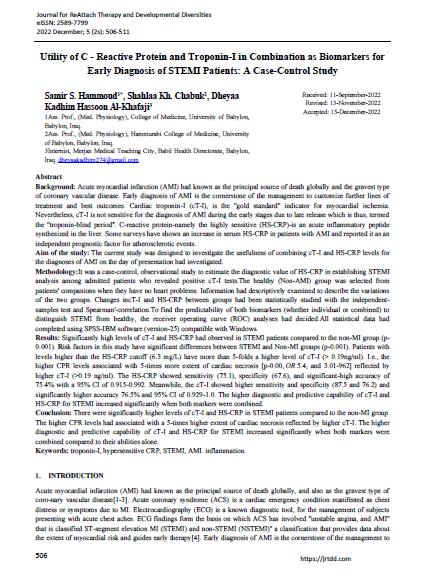Utility of C - Reactive Protein and Troponin-I in Combination as Biomarkers for Early Diagnosis of STEMI Patients: A Case-Control Study
Main Article Content
Abstract
Background: Acute myocardial infarction (AMI) had known as the principal source of death globally and the gravest type of coronary vascular disease. Early diagnosis of AMI is the cornerstone of the management to customize further lines of treatment and best outcomes. Cardiac troponin-I (cT-I), is the ''gold standard'' indicator for myocardial ischemia. Nevertheless, cT-I is not sensitive for the diagnosis of AMI during the early stages due to late release which is thus, termed the ''troponin‑blind period''. C‑reactive protein-namely the highly sensitive (HS‑CRP)-is an acute inflammatory peptide synthesized in the liver. Some surveys have shown an increase in serum HS‑CRP in patients with AMI and reported it as an independent prognostic factor for atherosclerotic events.
Aim of the study: The current study was designed to investigate the usefulness of combining cT-I and HS‑CRP levels for the diagnoses of AMI on the day of presentation had investigated.
Methodology:It was a case-control, observational study to estimate the diagnostic value of HS-CRP in establishing STEMI analysis among admitted patients who revealed positive cT-I tests.The healthy (Non-AMI) group was selected from patients' companions when they have no heart problems. Information had descriptively examined to describe the variations of the two groups. Changes incT-I and HS-CRP between groups had been statistically studied with the independent-samples test and Spearman'-correlation.To find the predictability of both biomarkers (whether individual or combined) to distinguish STEMI from healthy, the receiver operating curve (ROC) analyses had decided.All statistical data had completed using SPSS-IBM software (version-25) compatible with Windows.
Results: Significantly high levels of cT-I and HS-CRP had observed in STEMI patients compared to the non-MI group (p-0.001). Risk factors in this study have significant differences between STEMI and Non-MI groups (p-0.001). Patients with levels higher than the HS-CRP cutoff (6.3 mg/L) have more than 5-folds a higher level of cT-I (> 0.19ng/ml). I.e., the higher CPR levels associated with 5-times more extent of cardiac necrosis [p-0.00, OR 5.4, and 3.01-962] reflected by higher cT-I (>0.19 ng/ml). The HS-CRP showed sensitivity (75.1), specificity (67.6), and significant-high accuracy of 75.4% with a 95% CI of 0.915-0.992. Meanwhile, the cT-I showed higher sensitivity and specificity (87.5 and 76.2) and significantly higher accuracy 76.5% and 95% CI of 0.929-1.0. The higher diagnostic and predictive capability of cT-I and HS-CRP for STEMI increased significantly when both markers were combined.
Conclusion: There were significantly higher levels of cT-I and HS-CRP in STEMI patients compared to the non-MI group. The higher CPR levels had associated with a 5-times higher extent of cardiac necrosis reflected by higher cT-I. The higher diagnostic and predictive capability of cT-I and HS-CRP for STEMI increased significantly when both markers were combined compared to their abilities alone.

